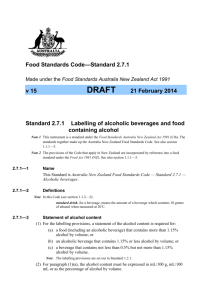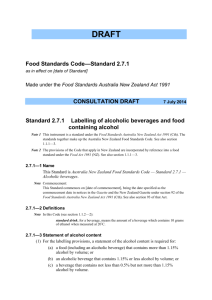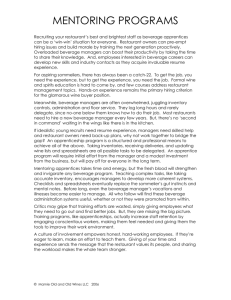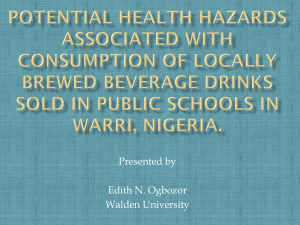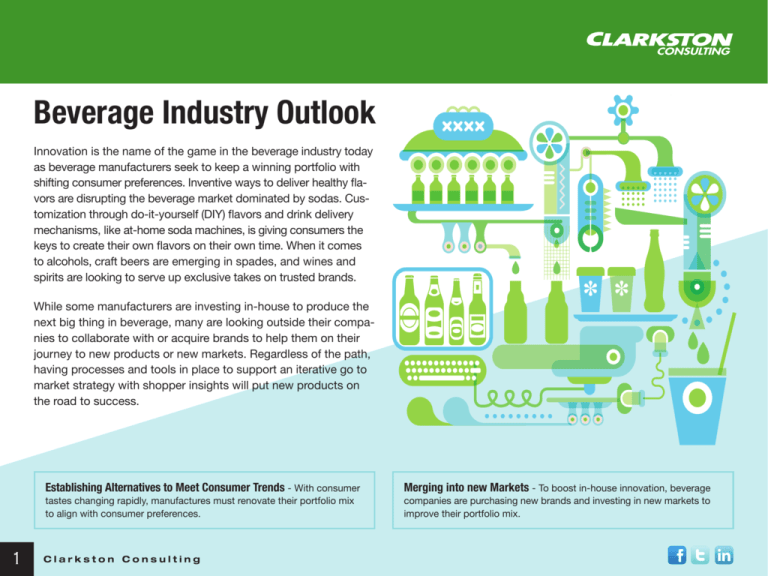
Beverage Industry Outlook
Innovation is the name of the game in the beverage industry today
as beverage manufacturers seek to keep a winning portfolio with
shifting consumer preferences. Inventive ways to deliver healthy flavors are disrupting the beverage market dominated by sodas. Customization through do-it-yourself (DIY) flavors and drink delivery
mechanisms, like at-home soda machines, is giving consumers the
keys to create their own flavors on their own time. When it comes
to alcohols, craft beers are emerging in spades, and wines and
spirits are looking to serve up exclusive takes on trusted brands.
While some manufacturers are investing in-house to produce the
next big thing in beverage, many are looking outside their companies to collaborate with or acquire brands to help them on their
journey to new products or new markets. Regardless of the path,
having processes and tools in place to support an iterative go to
market strategy with shopper insights will put new products on
the road to success.
1
2
Establishing Alternatives to Meet Consumer Trends - With consumer
Merging into new Markets - To boost in-house innovation, beverage
tastes changing rapidly, manufactures must renovate their portfolio mix
to align with consumer preferences.
companies are purchasing new brands and investing in new markets to
improve their portfolio mix.
Clarkston Consulting
BEVERAGE INDUSTRY OUTLOOK
Establishing Alternatives to Meet Consumer Trends
With consumer tastes changing
Substitute the Sweeteners
DIY Drink-ology
rapidly, beverage manufacturers
With stagnant sales volume of carbonated beverages and mounting social,
political, and regulatory pressures,1
beverage makers are seeking to produce alternatives that feel good to drink.
Better-for-you sugar substitutes, real
fruits and vegetables, and drinks that
are made locally are finding popularity.
There is a huge burst of creative DIY
drink making that ranges from mixing
flavors to getting your favorite coffee
shop flavors at home. Whether they’re
liquid or powder flavor additives, or
single serving drinks, beverage manufacturers are finding success in getting
drinks to consumers exactly how they
want them. DIY opportunities are at
every turn; Coke has seen a double
digit increase in servings from its Freestyle machines across the U.S. Leveraging new technology, these machines
mix known Coke brands with flavor
additives like vanilla or orange using
smaller cartridges instead of bulky
syrups combined with soda water.
are renovating their portfolio mix
to align with consumer preferences. Beverage companies are
releasing lower calorie alternatives to classic sugary drinks by
using various alternative sweeteners. The Do-it-Yourself (DIY)
trend put the power of flavor in
the consumers’ hands or dispensing machine. Looking for
ways to tap into local sentiment,
some beverage companies are
getting creative with small batch,
artisanal, and locally focused
drinks.
2
Clarkston Consulting
Companies are seeking exclusive rights
and patents to the next big thing in
sweeteners, like PepsiCo’s exclusive
rights to Sweetmyx this year. Many
health-aware consumers are skipping
the added sweeteners altogether and
harnessing the taste and benefits of
real fruits and vegetables. This trend
is moving out of the yoga studio and
into the home, endorsed by millenials,
celebrities, and the health conscious
across the nation. Consumers are
seeking drinks with health benefits
and peace of mind knowing
how to pronounce every
ingredient in a ready to
drink (RTD) beverage.
As beverage manufactures respond to this
trend, and walk the
line of boasting health
benefits, they may be
at risk of opening the
door to increasing regulation of functional foods.
BEVERAGE INDUSTRY OUTLOOK
Establishing Alternatives to Meet Consumer Trends
Local Sentiment
Manufacturer Impact:
Craft beer and craft soda are steadily
growing segments that address consumers’ desire for rich, local flavor
that feels nostalgic and homegrown.
Spirit manufacturers and cocktail artists
are getting creative with small-batch
and artisanal drinks. The well-known
vodka brand, Absolut, owned by Pernod Ricard, is kicking off the Our/Vodka
initiative to bring micro-distilleries to
several cities across the U.S. and other
countries. These municipal partnerships
will focus on creating a single Absolut
product using local ingredients and
tapping into the local communities
through tastings, communal forums,
and other events. Drink manufacturers
have an opportunity to hit the crossroads of transparency and customization for consumers by letting them
know exactly what is in their beverages
or where and how they are made.
Product Development : Drink manufacturers cannot rest on their sugary
laurels; consumers desire simpler,
healthier beverages that they can
customize and access any time. In
what ways do your products interact
with communities to incorporate
local flavors? How can you
offer a custom experience
with your products?
Value Chain: A change in
ingredients can often mean
a change in storage and
transportation processes.
It can even change the area
of the retail store where your
product is sold. Where in
the store does your new
product belong – with the
fresh, fast-paced store
perimeter or with the bulk
of drink selections in the
non-perishable center of
the store? Do you have the
right sales channels for
desired product placement?
Analytics: Do you have tools and
metrics in place to measure the impact
of new products? Access to real-time
analysis of end user data can also
guide decisions about marketing and
brand integrity. It helps combat any
3
Clarkston Consulting
nonconformity events and address
recall situations thoroughly and immediately. Analytics also create a more
agile innovation pipeline to quickly
respond to the market.
Promotions and New Product
Introductions: While innovation is
great, there are many challenges
incorporating the ever growing
SKUs into promotional processes
and systems. Do you have a mature
sales organization equipped to get
your products on the shelves without cannibalizing your current sales?
Are your systems and processes
ready to incorporate the many
new SKUs and product types
to help you achieve the impact
of your new investment
products?
BEVERAGE INDUSTRY OUTLOOK
Merging into New Markets
Many consumer products com-
The Risks with Brand Acquisition
Spirits Are Up in Emerging Markets
Manufacturer Impact
panies today are purchasing
The mixing of culture and identity of
two companies is often not a primary
consideration during M&A. Some
have found that gobbling up smaller
brands with core values that are
greatly different than the parent can
be more harm than help to the identities of each brand. Recently, companies on both sides of an acquisition
have faced loss of consumer trust
with petitions and boycotts accusing the smaller brand of “selling out.”
According to a Forrester study, brand
resonance, brand referral, and brand
preference all correlate with consumer trust at over 80%. While M&A
can be a great opportunity for smaller
companies to gain a greater audience
and make their message heard, they
must be selective such to maintain
their loyal consumer base and stay
true to their core values.
In addition to emerging products and
segments, brand identity should be
top of mind while expanding products to new audiences or regions.
The global share of emerging markets
reached 40% in 2010, and this number is expected to surpass developed
markets by 2020.2 The beverage industry in emerging markets grew from
$3 billion in 2001 to over $38 billion in
2012 and has created a rush to dominate in the largest emerging markets.3
M&A for Innovation: If you want to
take advantage of new segments or
emerging markets, consider the implications of in-house development
versus M&A activity. How do consumers relate to your brand, and does
that message align with potential acquisition targets? Are there attractive
targets with distribution capabilities
or brand recognition that are missing
in your current enterprise?
new brands and investing in new
technologies and markets to help
them establish the right portfolio
mix. Searching for diverse product
offerings through mergers or
acquisition is often times more
beneficial and efficient than trying
to break into a new market alone.
4
Clarkston Consulting
Rising standards of living across the
world and growing middle classes set
the stage for global alcohol manufacturers to establish brand loyalty and
grow in tandem. However, the premium image, price points and flavors
that bring success to spirit manufacturers in developed markets may not
garner the same success in today’s
emerging markets. Several factors
affect strategies around brand image
and distribution: cultural traditions,
regulatory environments, local market
protectionism, logistics networks and
the pace of economic growth.
Value Chain: When looking to move
into the M&A game, what is your strategy to ensure the new brand can be
fully leveraged? Do you have a plan of
merging the financials, processes, and
systems? Having a good M&A model
will allow you to expedite your integration time without losing consumers.
Culture is Key: Not only do employees
care about preserving cultures, but
now, your consumers do too. Do you
have a way to preserve the culture
of brands you are acquiring to ensure
your consumer base and employee
base will not disengage? Full organizational change management assessments can help you mange through
these turbulent transitions.
BEVERAGE INDUSTRY OUTLOOK
Continue the Discussion
About the Author
Kristine Pettoni is a
solution advisor with
Clarkston Consulting
and a leader in Clarkston’s sales, marketing and trade
management practice. Kristine has
over 10 years of experience working
in Consumer Products with Beverage
companies and has expertise in sales
and retail execution, trade promotion
and pricing, trade promotion optimization, customer segmentation and
downstream data and analytics.
Maggie Seeds is a
Food and Beverage
consultant enthusiastic about applying her
insights and experiences to move the industry forward.
Maggie’s cross-functional background
leaves her interested in a myriad of
issues faced by the industry, from
technical opportunities to strategic
ventures and global concerns.
Additional Reading
References
•Trade Marketing & Demand Planning Alignment for Improved Forecasting
•Commodity Mapping for Assessing Supply Chain Risks
1 Soda Sales are Failing, The Motley Fool, http://
www.fool.com/investing/general/2014/02/20/sodasales-are-falling-should-coke-be-worried.aspx
•Saving My Calories for the Weekend
2 Brand Breakout, Nirmalya Kumar and Jan-Benedict
Steenkamp
•Is One Supply Chain the Right Strategy?
•Build an Effective Merger, Acquisition and Divestiture Execution Capability
3 Growing Taste for Emerging-Market Drinks, Wall Street
Journal, http://online.wsj.com/news/articles/SB100
00872396390444100404577641252020063614
To continue the discussion on the Beverage Industry, contact
kpettoni@clarkstonconsulting.com.
About Clarkston Consulting
Headquarters
2655 Meridian Parkway
Durham, NC 27713
Phone: 800-652-4274
www.clarkstonconsulting.com
Copyright © 2014 Clarkton Consulting. All rights reserved. 1015_0914
5
Clarkston Consulting is a different kind of management and technology consulting firm. We deliver a unique experience for
market leaders within the Consumer Products and Life Sciences industries. Considering professionalism, expertise, and value
as prerequisites, we take service a step further through our unyielding commitment to the success of people as individuals,
both our clients and our employees. By combining integrity, adaptability, and a whatever-it-takes attitude, we have achieved
an extremely high rate of referral and repeat business and a 10-year average client satisfaction rating of 97%.

